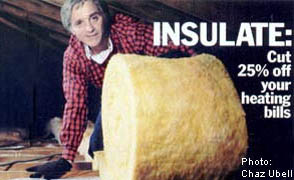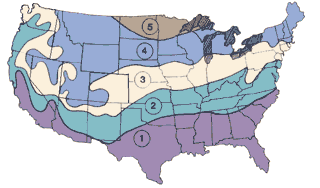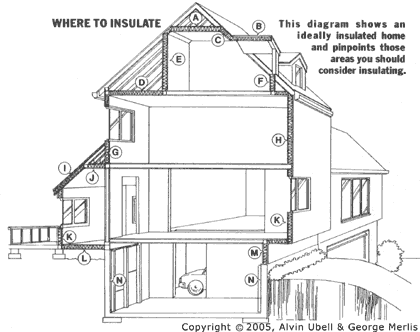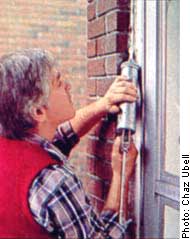- Publications:
- Newsletter:
- How-To Tutorials:
- Consumer Guides:
- Related:

Home Insulation Guide
Do It Yourself Installation

“Cut 25% Off Your Heating Bills”
By Al Ubell & Label Shulman
Published November 18, 1980 - Family Circle Magazine
Updated July 25, 2005

Yes, insulation really works. If you're spending $1,000 a year on heating bids, insulating your home properly can save you at least $250 this year and every year from now on. Over 10 years, that's $2,500 - well worth the initial investment you make. Best of all, you don't have to hire a pro for most insulation Jobs. Do it yourself following this step-by-step guide.
On a cold day, what do you wear? You know a parka or quilt-like coat will keep you the warmest because such garments insulate best, preventing your body heat from escaping. But if you happen to get caught outside dressed in just a thin sweater, you could keep warm by jumping up and down to burn calories and generate more body heat. Well, the situation is exactly the same with your house. It needs insulation in winter for the same reason you do. The important question is: What's your house got on? A thin, threadbare sweater or a down-filled parka? If your house is only “wearing a sweater” then your furnace will have to bum more energy to keep warm. It's a lot cheaper these days to buy your house that “down-filled parka” - insulation - than to feed your heating system more fuel. When buying insulation, it's important to understand R-values, because then you'll know just how heavy a “parka” to buy your home.
Know Your R Values

The effectiveness of insulation is measured in R-values. The higher the R-number, the more insulation value you get and the more money you eventually save. Imprinted on every batt or blanket of insulation or on every bag of loose insulation is its R-number.
| Heating Zone | Crawlspace or Basement Ceiling | Attic Floors | Exterior Walls |
|---|---|---|---|
| 1 | R-11 | R-26 | R-Value of full wall insulation, which is 3 1/2″ thick, will depend on material used. Range is R-11 to R-13 |
| 2 | R-13 | R-26 | |
| 3 | R-19 | R-30 | |
| 4 | R-22 | R-33 | |
| 5 | R-22 | R-38 |
How many R's do you need? That all depends on where you live. Find your home-heating zone on the map (of Climate Zones and Insulation Requirements) and check our chart for the R-value you need in your attic floor, exterior wall and other house areas. How much insulation should you buy? You can figure out how many square feet of insulation you'll need by measuring in feet the length and width of the area to be covered, and multiplying the two dimensions. The answer will be the square footage of insulation material necessary.
Then measure the distance between the wall studs or joists (wooden frames). If you're using batts or blankets of insulation, you'll need this measurement to buy them in the right widths. Batts and blankets are made in 16″, 20″ and 24″ inch widths. It's a good idea to buy a little extra insulation to be on the safe side, but be sure you can return unopened bags and still-wrapped batts and blankets. When insulating, you need vapor barriers. Pour yourself a glass of ice water in a nice, warm house and you'll find the outside of the glass wet - from dew. Install insulation without a vapor barrier and dew will form, rotting wood, corroding electrical wiring and eroding plaster. When warm, moisture-laden air hits cold surfaces in unheated portions of an attic and walls, dew forms. However, if you place something to stop the moisture between the cold surface and the heated air, dew won't form. Unfortunately, insulation won't do the job by itself. You need a vapor barrier between the warm portions of the house and the insulation.
Many batts and blankets of insulation have a vapor barrier already attached. All you have to remember to do is install the insulation with the vapor barrier closest to the heated area. For other forms of insulation, it's necessary to lay down or nail up a vapor barrier (usually aluminum foil, saturated kraft paper, strong wrapping paper, or plastic sheeting) before installing the insulation. However, when insulating a cock-loft or exterior wall, it is often impractical or impossible to install a vapor barrier. In these instances, a moisture-blocking effect can be created by papering the wall with a vinyl wallpaper or by painting the wall or ceiling with two coats of good-quality oil-based paint.

| Diagram Label | Home Areas to Insulate |
|---|---|
| A | Between attic collar beams |
| B | In cockloft beneath flat roof |
| C | In roof rafters adjacent to living spaces |
| D | Attic floors |
| E | In knee walls adjacent to attic spaces |
| F | In knee walls adjacent to attic crawlspaces |
| G | In exterior walls adjacent to unheated spaces |
| H | In exterior walls |
| I | In sloping roofs heated areas |
| J | Ceilings below unheated areas |
| K | Exterior walls below window sections |
| L | Floors above crawlspaces |
| M | Exposed framing above foundations |
| N | Foundation walls in heated basements |
Up In The Attic
Starting from scratch: If there is no insulation in your attic, roll batts of insulating material between the joists (frames) with the vapor barrier facing down. If you're using loose insulation material, place vapor barrier between joists and then pour in material. Level with a rake or straight stick.
If your attic already has some insulation: Lay new batts of insulation over existing material at right angles to the joists. But be sure the new insulation has no vapor barriers, or slash the vapor barriers on the new batts to enable old insulation to “breathe.” Install new batts with the slashed barrier facing down. If your old insulation has a kraft-paper covering facing up, cut slashes in that to enable moisture to escape into the attic. Note: Whether you're installing the first insulation in your attic or increasing the insulation already there, be sure you don't block ventilation openings in eaves and in gable ends.

Four Nooks & Crannies Not To Be Overlooked
Don't forget attic trap doors: Remember that unzipped down-filled parka? Well, an uninsulated attic trap door wastes energy like an open parka. Insulate it. You can staple insulation material directly to it. (Remember to keep the vapor barrier facing the heated area of the house.)
Insulate under floorboards or catwalks in your attic: The flooring over the joists may be hiding an uninsulated area. Even if you must temporarily remove the flooring, it's worthwhile to get insulation between those joists.
Insulate all heating and cooling ductwork in attic, basement or crawlspace with at least two or three inches of fiberglass.
Vent pipes, electrical conduits and chimneys coming up through your attic floor should also have in-hand-packed around them.

Copyright © Alvin Ubell, Label Shulman & Family Circle Magazine - 1980
Accurate Building Inspectors ®
www.AccurateBuilding.com




